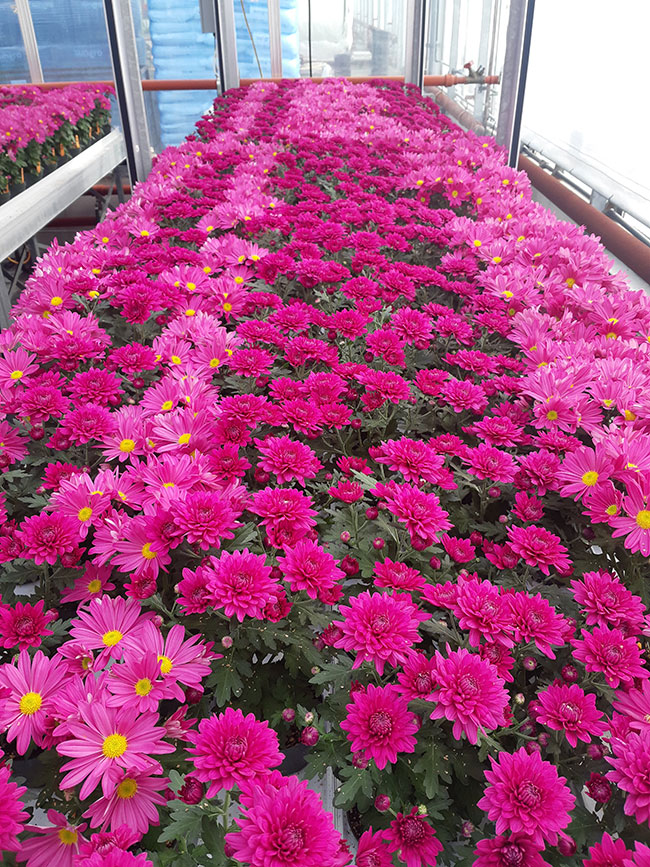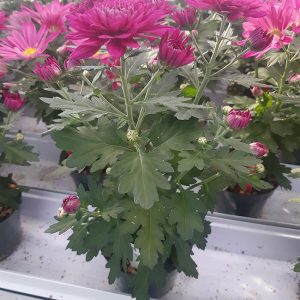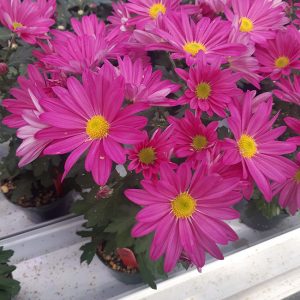
Features
Fertilizer
Flowers
How much calcium and magnesium do chrysanthemums need?
November 3, 2020 By Skye Duncan Stephens, Edward J. Flaherty, William (Bill) N. MacDonald, and Dr. Barry J. Shelp
 Figure 1. Market-quality ‘Milton Dark Pink’ and ‘Williamsburg Purple’ chrysanthemums were produced using different Ca and Mg regimens.
Figure 1. Market-quality ‘Milton Dark Pink’ and ‘Williamsburg Purple’ chrysanthemums were produced using different Ca and Mg regimens. Closed subirrigation systems are popular in modern greenhouse floriculture operations for reducing the input of nutrients, especially nitrogen, phosphorus, boron and molybdenum. Nevertheless, the recirculated nutrient solution must be refreshed occasionally and eventually discharged or treated in accordance with applicable environmental legislation. Optimizing nutrient delivery can further reduce fertilizer use over the crop cycle.
Approximately 10 years ago, we began to optimize the subirrigation strategy for delivering macronutrients using chrysanthemum, a common potted ornamental crop in Ontario, as well as Canada, as our plant model. Our objective was to systematically evaluate each of the nutrients essential for plant growth because their unique chemical properties could differentially influence their ability to be stored and moved throughout the plant in response to varying nutrient supply.
Previously, we demonstrated that the entire nutrient supply for subirrigated chrysanthemums could be removed at the onset of flowering. At the same time, we reduced the supply of nitrogen, phosphorus or sulphur during vegetative growth by 50-75 per cent compared to industry standards and without adversely affecting plant or flower quality. If these trends hold for the remaining macronutrients, that is calcium (Ca) and magnesium (Mg), as well as the micronutrients, our modified delivery strategy would enable the production of plants with a more balanced nutrient status and the formulation of new commercial fertilizers.
Calcium has important roles in cell integrity, flower development and cell signaling. Its low mobility in plants means that it is not redistributed during times of calcium deficiency, and that a constant supply is generally required during plant growth. Magnesium has roles in light absorption, energy production and use, carbon dioxide fixation, carbohydrate transport, and enzyme synthesis. It is highly mobile in plants, so it is effectively redistributed within the plant when supply is limited.
In this study, we were able to reduce the Ca or Mg supply to two modern subirrigated chrysanthemum cultivars during vegetative growth, while removing the entire nutrient supply at the onset of flower growth. This research contributes to the development of our modified delivery practice and further lays the foundation for low-input production.
EXPERIMENTAL SET-UP
Pinched, potted chrysanthemums were grown in a peat-perlite mix under greenhouse conditions (January to March 2019) using two cultivars (‘Milton Dark Pink’ and ‘Williamsburg Purple’). The study tested three Ca (170, 85 and 42.5 ppm) or Mg (62, 31 and 15.5 ppm) treatment rates, each replicated in four different areas of the greenhouse. The highest concentrations were equivalent to the levels found for both nutrients in Sonneveld’s solution. Treatments were supplied in an otherwise complete nutrient solution until bud break (i.e., until early flowering), and then replaced with deionized water thereafter.
Immediately prior to removing the nutrient supply, recently-matured leaves were randomly collected from each plant and pooled for analysis of Ca and Mg. Similar to the floricultural practice of using leaf tissue analyses to diagnose nutrient deficiencies, this step was used as a way to monitor and verify deficiency in these nutrients.
Plants were harvested at approximately eight weeks after short days were imposed to induce flowering, and assessed for visual quality and plant/bloom characteristics. Vegetative characteristics were assessed as shoot height and dry mass. Flower characteristics were assessed as dry mass, number of flowers/flower buds, bloom diameter and bloom development (from bud formation to fully open blooms).
QUALITY UNCHANGED
In the Ca trial, leaf Ca levels at bud break ranged from 1.69 to 0.78% of dry mass, across both cultivars, and significant decreases were found with decreasing Ca supply. However, these levels still fall within the desirable range for Ca laid out by the Ontario Ministry of Agriculture, Food and Rural Affairs (OMAFRA) in Publication 370, which suggests 0.5% to 4.6% Ca concentration in plant dry tissue for chrysanthemum.
There was no effect of Ca treatment on the vegetative and flower features of either cultivar. Regardless of treatment, the flowers were of market quality, and there were no visible signs of Ca deficiency (i.e., death of apical meristems, stunting of shoots, inhibition of flower formation, reduced yield, enhanced senescence) on the flowers, leaves or shoot tips .
In the Mg trial, leaf Mg levels at bud break ranged from 0.54 to 0.30% of dry mass across the Mg treatments, also falling between OMAFRA’s suggested range of 0.1 to 1.5% Mg of plant dry mass. Some of the vegetative and flower characteristics were slightly affected by the decreasing levels supplied, but these changes were inconsistent across the two cultivars. Regardless of treatment, the flowers were of market quality, and there were no visible signs of chlorosis on mature leaves.
FROM RESEARCH TO APPLICATION
Many nutrient formulations are now available for cultivating greenhouse chrysanthemums. Modern commercial examples include Fusion Plant Products 17-5-7 (Plant Products) and Peter’s Professional 17-3-17 (ICL Fertilizers), which contain 31-44 ppm Ca and 28-37 ppm Mg at 285-295 ppm N. More historical nutrient solutions contain much higher Ca and Mg levels. Sonneveld’s solution was developed for flowers and vegetables and has 170 ppm Ca and 62 ppm Mg at 260 ppm N. As our studies on chrysanthemum nutrition began approximately a decade ago, we chose Sonneveld’s solution as the industry standard at the time. In this study, we investigated Ca and Mg levels that covered the approximate range of Ca and Mg levels found in the different nutrient solution formulations described above
With no visible effects on flower quality or crop health at the lowest concentrations of Ca and Mg supplied, this strategy reduced approximately 87.5% of Ca and Mg delivered over the crop cycle. Leaf levels of Ca and Mg declined by 30-34% and 2-12%, respectively, but can be considered acceptable based upon the lower limits from guidelines in the extension and scientific literature.
This interpretation is supported by the absence of visible signs of Ca or Mg deficiency, and of inconsistent minor responses in plant and flower quality of the two cultivars. Thus, it can be concluded that chrysanthemum growth was not limited by any of the Ca and Mg regimens used here, regardless of the nutrient’s mobility.
Comparisons of Ca and Mg levels supplied in the nutrient solution to the levels measured in the leaves indicate that the crop was able to use Ca and Mg more efficiently with decreasing supply. Both increased approximately four-fold based on decreasing supply during vegetative growth, and eight-fold based on the delivery of these nutrients over the entire crop cycle, compared to Sonneveld’s solution.
To more closely determine the minimum levels required for attaining maximum yield, lower rates of Ca and Mg, possibly even suboptimal levels, must be investigated. Challenging the plants and monitoring their responses in terms of maintaining growth and quality at near limiting fertilizer rates would go a long way towards addressing the big picture of low-input production.
Acknowledgements: This project is part of the Accelerating Green Plant Innovation for Environmental and Economic Benefit Cluster and is funded by the Canadian Ornamental Horticulture Alliance (COHA-ACHO) and the Government of Canada under the Canadian Agricultural Partnership’s AgriScience Program. Industry partners include AgMedica Bioscience Ltd. (Ont.) and Schenck Farms and Greenhouses (Ont). Thank you to Berger for supplying the potting mix.
For more details, see the article, “Further optimization of macronutrient delivery for subirrigated greenhouse-grown chrysanthemums: Calcium and magnesium”, published in the Canadian Journal of Plant Science (doi.org/10.1139/CJPS-2020-0117).
For more background, see the articles on nitrogen, sulphur and phosphorus reduction for subirrigated chrysanthemums published in the December 2018, July 2019, and March 2020 issues of Greenhouse Canada magazine.
Skye Duncan Stephens is a graduate student, Edward Flaherty is a technician, and Barry Shelp is professor emeritus in the Department of Plant Agriculture at the University of Guelph. Bill MacDonald is professor of Horticulture at Niagara College. For more information, contact Dr. Shelp at 518-824-4120 ext. 53089, or bshelp@uoguelph.ca.
Print this page



